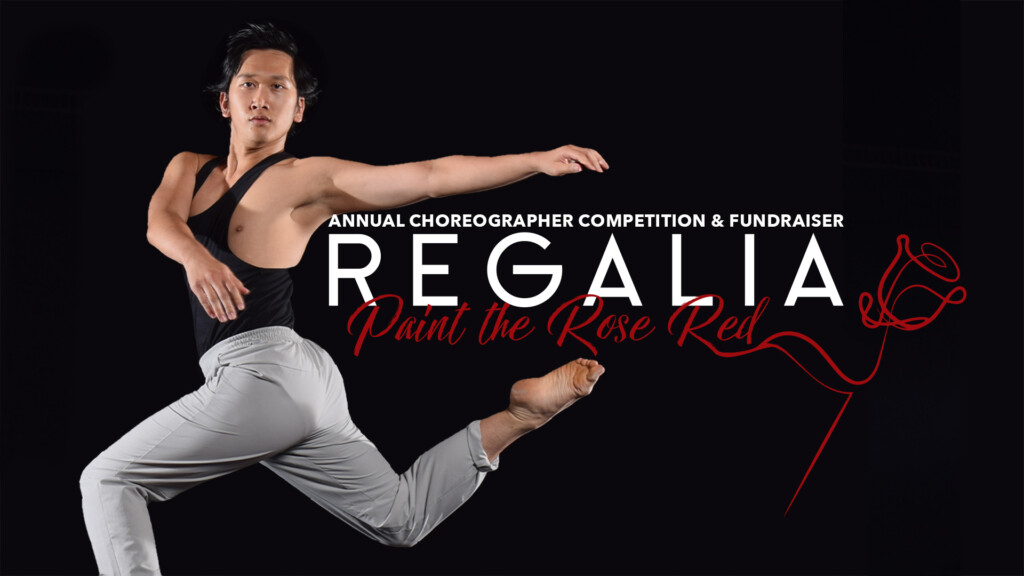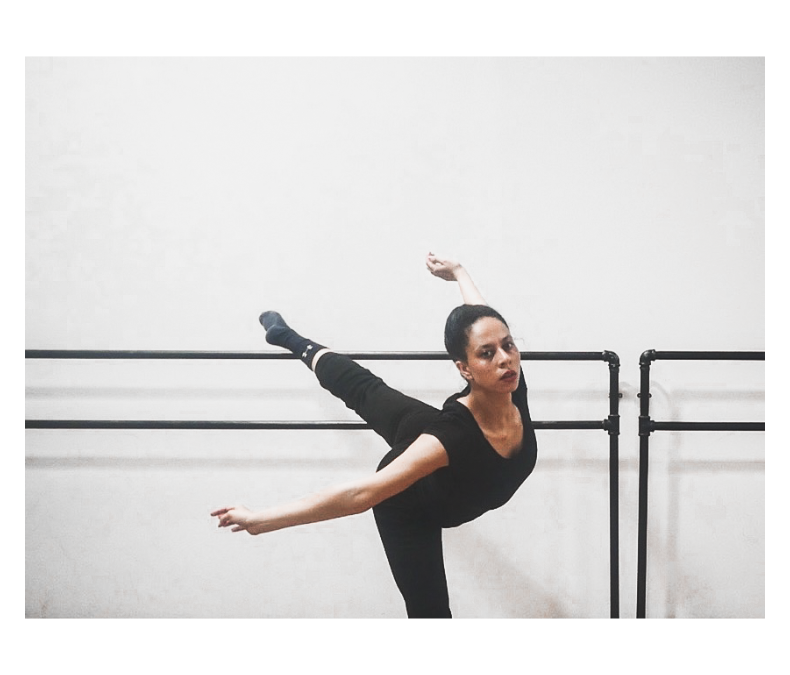For the first time in three years, Repertory Dance Theatre (RDT) is holding Regalia, its largest annual fundraiser, in person. As usual, the stakes are significant. Four choreographers are assigned a group of dancers to create a short work (usually five but less than 10 minutes in length) in just four hours. The kicker is that the audience decides who wins the competition and receives the prize — a commission to create a complete work in the 2023-24 season. This year, all four choreographers have strong Utah ties and presence.
There is one major twist in this year’s event. While the audience will see the works for the first time on Feb. 4 at 8 p.m. in the Rose Wagner Center for Performing Arts and cast their votes, voting for choreography will continue for one week after the live event. The new works will be filmed and uploaded to be viewed online and audiences can continue to donate to their favorite choreographer through Saturday, Feb. 11 when the final commission will be awarded.
Regalia is also a big party. A pre-show cocktail party, complete with hors d’oeuvres, will begin at 6:30 p.m. Attendees also will have the opportunity to pop into the four studios, to observe the choreographers put the finishing touches on the works that will be presented later in the evening. The choreographers begin their work at 2 p.m. Audience members will “vote with their wallet,” by using their mobile phones during the event. There also will be a silent auction for attendees to bid on various Utah gift and experience packages. Following the 8 p.m. performance, everyone including the audience will be invited on stage for dessert and dancing, with music by the Joe Muscolino Band.
This year’s hosts for Regalia are two familiar faces to RDT audiences: former RDT dance artist Justin Bass, who received the Regalia commission in 2020, and Angela Banchero-Kelleher, an RDT alumni dancer and UVU professor whose works are included in the company’s repertoire.
Regalia has been a major fundraiser for RDT’s arts-in-education program that has continued throughout the pandemic. The program reaches approximately 40,000 students and teachers in Utah annually. For tickets and more information, see the RDT website.
The Utah Review interviewed by phone or in writing all four choreographers for this year’s Regalia:
Constance Anderson, a master of fine arts degree candidate in modern dance at The University of Utah, is focused on creating site-specific work that augments and amplifies a venue’s architecture. Her company, Sock Opera Dance, which she established in 2019, enhances the creative experimentation of the process and works in which she created such works.
In an interview with The Utah Review, Anderson describes her preparation for Regalia as “front heavy,” gathering research about the artists and the venue to envision opportunities for experimenting with the place in terms of what is technically feasible while satisfying the artistic objectives for themes and aesthetics. As with many choreographers, she approaches the Regalia challenges of a swift-moving compact timeline for creating a dance composition as a problem solving exercise.
Among the works that she considers as inspirational and influential for developing her own movement language is Bodies of Water, which premiered in 2016 in Seattle as a five-hour hybrid performance spectacle by Italian-American choreographer Alice Gosti, in collaboration with composer Benjamin Marx, produced by Velocity Dance Center. Also, she is drawn to the work of the U.K.-based Gecko, an internationally touring physical theater company, as well as works by Karl Wilhelm Alexander Ekman, a Swedish ballet dancer and choreographer. One of Ekman’s most noted works was Cacti, featuring 16 dancers who collaborate on creating rhythms. The work so impressed Queen Beatrix of The Netherlands that she gave the work as a gift to the Norwegian royal family.
Anderson’s graduate studies have also emphasized philosophy and phenomenology, which nicely augment other influences such as clown based theater, film and fashion, especially the works of figures such as Wes Anderson, Alexander McQueen and Vivienne Westwood. This segues smoothly into hearing about her thoughts about the Regalia experience, where the experience of having the dancers being seen by the audience not just at the performance but also in the studio makes it that much more accessible. “I am not a fan of esoteric or thick sorts of work, so I like the approachable and tangible effects of making work that has very theatrical elements and aesthetics,” she says.
A ballet instructor who worked on her master of fine arts degree in The University of Utah’s ballet program, Rebekah JoAnn Guerra incorporates themes of the fragility and force of the human condition, where the stage becomes the playground for the intersections of the individual’s inner self, the natural contradictions and complexities of human emotions and domestic politics. Since 2020, Guerra has worked as a freelance artist in Los Angeles. Her choreography and films have been presented at the Lift-Off Film Festival-Paris; Inland Empire Dance Festival, Long Beach Black Dance Festival; ModCollective in Brooklyn, NY; Bond Performance Festival-Hong Kong; and Stomping Ground-Los Angeles. Presently, She is a ballet instructor and an MFA Recipient in the Ballet Program at the University of Utah.
In her written responses to interview questions by The Utah Review, Guerra says Regalia will be a variation of her typical process but with a little extra preparation before entering the studio this Saturday. “I count the music and mark specific shifts in sound that I would like to impact the movement,” she explains. “In the studio, the dancers and I begin with improvisation that allows us to warm up our awareness, sensitivities, and ‘spidey senses’ towards one another. Then we create a bank of movement together through various movement-based tasks.” From that point, Guerra them turns the focus onto structuring the choreographic narrative. “I also write a lot during this part of the process. The ‘building structure’ process is a lot like forming sentences, and writing helps to give me clarity when things appear chaotic.”
Her influences come from different planes. “My parents firstly because they always reinforced the value of living in my truth. Truth-telling is in the foreground for every work that I do,” Guerra says. “I am always after the truth about the inner narrative that exists inside each dancer. When a dancer is honest and not withholding, true beauty comes through, and you can’t look away.
Other creative influences reflect an eclectic yet broad spectrum of interests: Micaela Taylor, Akram Kahn, Rena Butler, Bobbi Jene Smith and Or Schraiber, Saar Harari, Sofia Carreras, Roya Carreras Sue Roginski, and Kirsten Johanssen. Others are Frida Kahlo, Edith Piaf, Nina Simone, and Chavela Vargas; filmmakers such Jean-Luc Godard, Aviad Givon and John Cassavetes, Amd writers like Maya Angelou and W.E.B. Du Bois.
Guerra sees Regalia as an egalitarian experience not just for the dancers but also for the audience. “We are all born with dance inside of us. We all have access to move and to move others. People and spaces are not always accessible or approachable,” she says. “This is slowly changing in the world of performing arts. More people are opening up more space. All we have to do is open our doors to people who cannot normally afford to sit in theaters. The people who hold power over spaces are responsible for giving or withholding access for others to experience the power of dance.”
Ruger Memmott, dancer and choreographer from Pleasant Grove, grew up in the competitive dance circuit and worked with numerous styles of dance. He danced on scholarship with the BYU’s Theater Ballet Company and then after returning from his church mission, he danced freelance in Utah and California, including with Utah’s Odyssey Dance Theatre, where he occasionally choreographed works. His choreography has been selected by the Palm Springs Desert choreography festival, the MOVE: A 24-Hour Film Festival competition by the Utah Film Festival and he was selected as the winner of the 2021 SHAPE choreography festival by SALT Dance.
In his written responses to interview questions by The Utah Review, Memmott says, “prepping for this experience [Regalia] will be different for me than what I usually do.” He adds, “My preferred process is much more time intensive and I like to bounce ideas and phrases off the dancers in studio, in order to land on the final product. I am attempting to do some of this in advance, but I think that much of what will be required now is just trusting my creative decisions and moving forward quickly.”
As for influences, Memmott cites his mother and sister who are both dancers, teachers, and choreographers. “I also have worked with and been mentored by Teddy Forance. All of these have contributed significantly to how I view dance and approach creating it,” he adds.
For Memmott, Regalia can be a new experience for someone who might have never attending an RDT event or show. “I think that the important thing is to get people to a show or concert at least once,” he says. “People need to experience dance in order to love it. Raising support and exposure for the arts are vital.”
A northern Idaho and Brigham Young University graduate, Angela Smith was highlighted as a choreographer by Sarasota Contemporary Dance Company and her work with BYU’s DancEnsemble company was chosen for the gala concert at the American College Dance Association in Slippery Rock, Pennsylvania. Angela approaches her choreographic process with passionate and playful curiosity. As more new generation choreographers have explored, Smith blends dance and theater, looking for both abstract and representative elements in her choreographic narrative compositions.
When asked about her choreographic influences in an interview with The Utah Review, she says, “I started in ballet so I’ve always been really interested in dance as a storytelling tool. The first dances I was exposed to were classical ballets,” adding that included her personal favorite Coppélia, the 19th century comic ballet choreographed by Arthur Saint-Léon to the music of Léo Delibes, with libretto by Charles-Louis-Étienne Nuitter. “Contemporary ballet choreographers like Christopher Wheeldon and Christian Spuck had a big impact for me in learning that dance could also be witty and make a social commentary and left me wanting to create things that are more socially aware,” she explains. “The choreographer whose work really kick-started my interest in choreography was Alejandro Cerrudo with his work little mortal jump. I’ve always strived to emulate the way he merges humor with emotion.”
Smith also has been inspired locally by Graham Brown’s work in dance theater, notably SONDERimmersive, which has presented several successful site-specific works in this hybrid performing arts genre. “He helped me discover Pina Bausch and the Pearson-Widriig dance theater whose works have been deeply impactful for me in developing my own artistic voice,” she adds. “My professor, Kate Monson, also had a huge impact on me. Her work often dives into the bizarre in a way that I really resonate with. She’s always encouraged me to follow my crazier ideas.”
Smith says the Regalia format — where choreographers are given a prompt 24 hours before the scheduled premiere of their work and the fact that they start working with dancers in the studio on 2 p.m. of the day of performance — means relying on movement improvisational structures to drive the process.
“Trying to nitpick wil really slow it down,” she says. While some choreographers come into the studio with music or sound design already decided, Smith says music will be the last element she will incorporate to match with the movement and gestures, which will be developed. For her, Regalia “peels back some of the mysticism associated with dance,” she explains, adding that “friends and family can come and watch rehearsal process and observe the humanity of it. The proscenium stage setting normally makes it more distant and inaccessible but here the audience can visit the studio before the performance, which makes the experience more relatable.”






